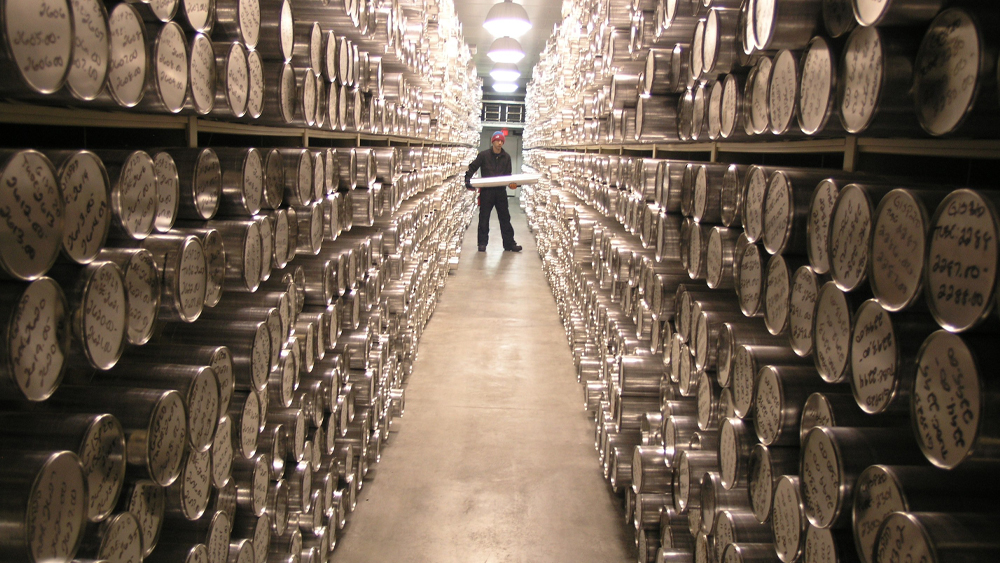Scientists have successfully drilled a fourth long ice core in East Antarctica.1 This new core, which reached to bedrock, has bottom ice that is believed to be, by uniformitarian reckoning, at least 1.2 million years old. This is a huge technical achievement that required years of work in bitterly frigid temperatures. But it is also great news for creation science, since this new ice core could greatly strengthen already strong arguments that the vast ages typically assigned to these ice cores are greatly inflated.2–4
Creation scientists think the thick ice sheets of Greenland and Antarctica formed rapidly during the roughly 700-year-long Ice Age triggered by the Genesis Flood about 4,500 years ago.5 Uniformitarian scientists believe the ice sheets are millions of years old. Is there a way to discern which model is more reasonable? Yes, there is. Volcanic eruptions occasionally deposit layers of ash and volcanic debris called tephra onto the ice sheets. These tephra layers are often visible within the ice cores.6 Uniformitarian age models predict extreme thinning of annual ice layers deep within the cores. For this reason, these models typically assign the vast majority of the ice core’s age (say, about 85%) to the bottom halves of the cores.
If the bottom ice core halves really do represent much more time than the top halves, one would naturally expect the vast majority of the tephra layers to appear in the bottom halves of the cores. However, this isn’t the case. In all three deep Antarctic ice cores, the tephra layers show no obvious pattern with depth. The locations of these tephra layers within the cores may be seen in Figure 2 in reference 4.
When uniformitarian scientists use their age models to transform the depths of these volcanic layers into ages, a strong pattern emerges. Their models imply that tephra deposits almost never fell on East Antarctica until about 200 thousand years ago (Figure 3 in reference 4). The pattern is so obvious that even uniformitarian scientists found it remarkable.7 But why would this be the case, especially if “the present is the key to the past,” as we are constantly being told?
Creationists have a straightforward answer. The apparent infrequency of tephra deposits until 200 thousand years ago (on the conventional timescale) is a systematic error in uniformitarian age models. These models are assigning hundreds of thousands of imaginary years to the ice core bottoms, causing tephra layers to seem ridiculously infrequent in the distant past. Moreover, these models imply that one particular tephra deposit in the Dome Fuji ice core was deposited over the course of about five years.6,8 This is clearly unreasonable since tephra usually falls out of the atmosphere over a matter of weeks or months, at most.9
Creationists fully expect these “weird” tephra patterns to also appear in this fourth ice core.10,11 In two technical papers, I suggested ways creationists could estimate annual layer thicknesses in ice cores.12,13 This could allow us to compare uniformitarian and creationist predictions for tephra layer frequencies and thicknesses within the ice. An independent creation researcher is already aggressively working to that end. Tephra patterns in the Antarctic ice cores already provide strong evidence that the conventional age assignments are grossly inflated, but new tephra data from this fourth ice core, as well as new creationist ice sheet models, could greatly strengthen the argument that the ice sheets are just thousands, not millions, of years old.
References
- Santalucia, P. Scientists Drill Nearly 2 Miles Down to Pull 1.2 Million-Year-Old Ice Core from Antarctic. AP. Posted on apnews.com January 9, 2025, accessed January 10, 2025.
- Oard, M. J. 2016. Little Erosion Beneath Antarctic and Greenland Ice Sheets. Journal of Creation. 30 (1): 11–14.
- Hebert, J. 2018. Tephra and Inflated Ice Core Ages. Journal of Creation. 32 (3): 4–6.
- Hebert, J. 2019. Earth’s Thick Ice Sheets Are Young. Acts & Facts. 48 (2): 11–14.
- Hebert, J. 2018. The Bible Best Explains the Ice Age. Acts & Facts. 47 (11): 10–15.
- Hebert, J. 2018. Bill Nye, PBS Highlight Young-Earth Evidence. Creation Science Update. Posted on ICR.org April 27, 2018, accessed January 10, 2025.
- Narcisi, B., J. R. Petit, and B. Delmonte. 2010. Extended East Antarctic Ice-Core Tephrostratigraphy. Quaternary Science Reviews. 29 (1–2): 21–27.
- Fujita, S. et al. 1999. Tephra Layers in the Dome Fuji (Antarctica) Deep Ice Core. Annals of Glaciology. 29: 126–130.
- Sulfuric acid droplets produced from explosive volcanic eruptions can remain aloft in the stratosphere for about two years, but tephra falls out of the atmosphere much more quickly.
- Hebert, J. New Ice Core Expected to Contain Creation Evidence. Creation Science Update. Posted on ICR.org November 18, 2021, accessed January 10, 2025.
- Hebert, J. 2021. ICR Ice Core Research Continues. Acts & Facts. 51 (1): 10–13.
- Hebert, J. 2021. Using Vardiman’s Young-Earth Ice Sheet Model and a Simple Computer Code to Estimate Annual Layer Thicknesses. Creation Research Society Quarterly. 57 (3): 175–185.
- Hebert, J. Towards a More Realistic Young-Earth Ice Sheet Model: A Shallow, Isothermal Ice Ridge with a Frozen Base. Creation Research Society Quarterly. 59 (4): 241–251.
* Dr. Jake Hebert is a research associate at the Institute for Creation Research and earned his Ph.D. in physics from the University of Texas at Dallas.





